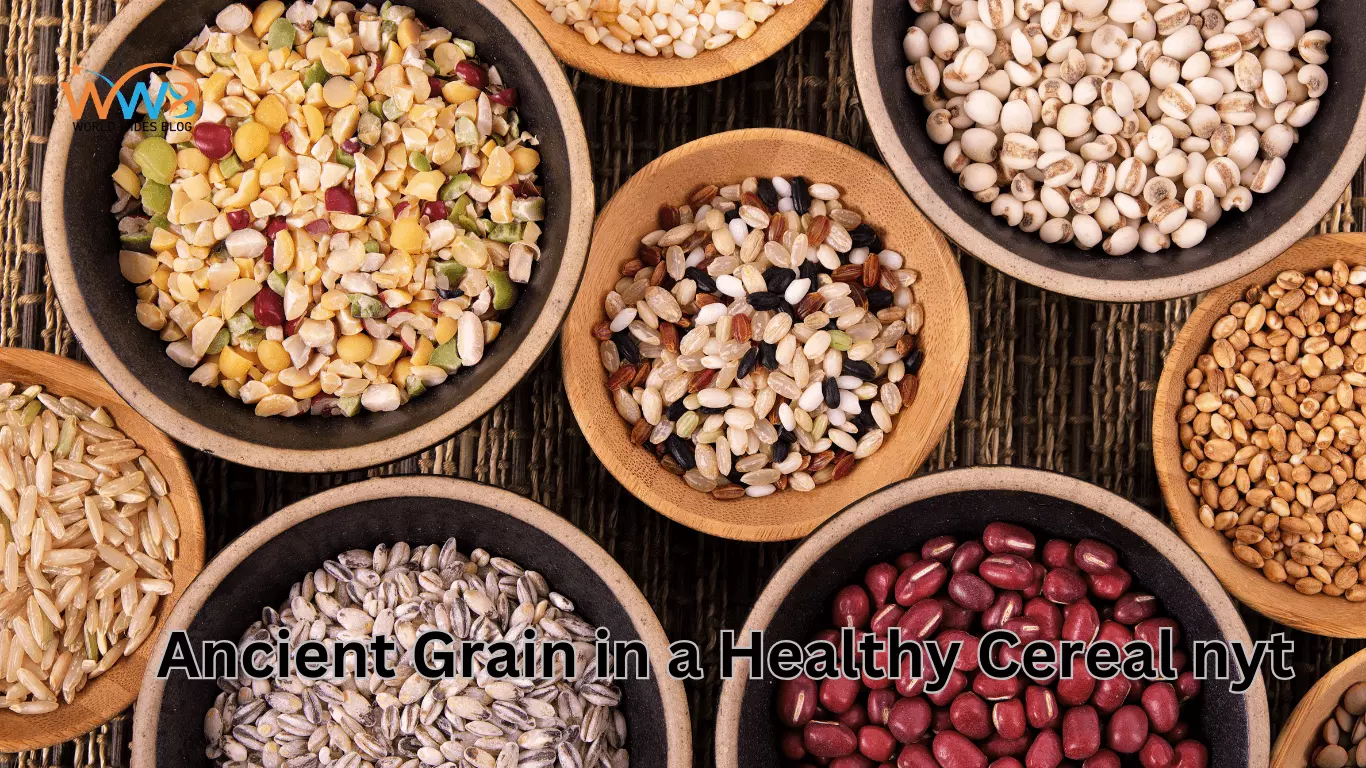Ancient grain in a Healthy Cereal nyt has found a lasting place in the spotlight in a world where food trends come and go. These time-honored grains have been cherished for centuries, yet their resurgence in modern diets speaks volumes about their nutritional value and sustainability. Whether strolling through a grocery store or reading up on the latest health trends, it’s hard to miss the growing popularity of ancient grains, especially in cereals. So, what’s all the buzz about? Why are these grains returning, and what makes them so unique?
What Are Ancient Grains?
Ancient grains refer to a group of grains and pseudocereals that have remained relatively unchanged for thousands of years. Unlike modern wheat or corn, which have undergone extensive breeding and modification, ancient grains have been passed down in their original form. This gives them a unique place in our diets, as they offer a nutritional profile often superior to their modern counterparts.
Ancient grains are nutrient-dense, rich in fiber, protein, and essential vitamins and minerals. They’re also packed with antioxidants and phytochemicals that support overall health. But what makes them unique is their ability to withstand harsh conditions. These grains have adapted to grow in harsh conditions, making them both a nutritious choice and an environmentally sustainable one.
Popular Used Ancient Grain in a Healthy Cereal nyt
What are the 6 ancient grains?
When it comes to healthy cereals, several ancient grains stand out:
- Quinoa: Quinoa has all nine crucial amino acids. This means it is a complete protein. It is an excellent choice for vegetarians and vegans.
- Amaranth: This superseded has protein, fiber, and essential nutrients like magnesium and phosphorus. Its nutty flavor adds a delicious twist to cereals.
- Millet: This gluten-free option is rich in B vitamins, magnesium, and calcium. It is light and fluffy, perfect for those seeking a gentle cereal.
- Teff: This tiny grain is a powerhouse of iron, fiber, and protein. It does not have gluten, so people with celiac disease can eat it.
- Spelled: An ancient wheat alternative, spelled is high in fiber, protein, and essential minerals. It is easier to digest than modern wheat. It also has a sweet taste.
- Farro: Farro is chewy and contains a lot of fiber. It also contains iron, magnesium, and zinc. It’s perfect for adding a hearty touch to cereals.
Health Benefits of Ancient Grain in a Healthy Cereal Nyt
The health benefits of incorporating ancient grain in a Healthy Cereal nyt into your cereal are numerous:
- High Nutrient Density: Ancient grains are packed with vitamins, minerals, and essential nutrients, making breakfast delicious and nutritious.
- Rich in Fiber and Protein: These grains keep you full longer, helping with weight management and promoting digestive health.
- Gluten-Free Options: Many ancient grains, like quinoa, millet, and teff, are naturally gluten-free, making them suitable for those with gluten intolerance or celiac disease.
- Antioxidants and Phytochemicals: Ancient grains are rich in antioxidants, which fight inflammation and support overall health.
- Support for Digestive Health: Ancient grains’ fiber content promotes healthy digestion, reduces the risk of colon cancer, and helps regulate blood sugar levels.
The Environmental Impact of Growing Ancient Grains
Ancient grains are healthy for you. They are also suitable for the planet. These grains are often grown using sustainable farming practices that help preserve the environment:
- Sustainable Farming Practices: Ancient grains typically require less water and fewer chemical inputs than modern grains, making them a more sustainable choice.
- Biodiversity and Ancient Grains: Growing a variety of ancient grains can help maintain biodiversity, which is crucial for resilient food systems.
- Soil Health and Ancient Grains: These grains are often grown in rotation with other crops, which helps improve soil health and reduce the need for synthetic fertilizers.
- Ancient Grains and Climate Resilience: Many ancient grains naturally resist pests and diseases and can thrive in poor soil conditions. This makes them a valuable crop in the face of climate change.
Incorporating Ancient Grain Cereals into Your Diet
Adding ancient grain cereals to what you eat is easy.
- Breakfast Ideas: Start your day with a quinoa or amaranth porridge, topped with fresh fruit and nuts.
- Snacks and Smoothies: For a nutritious boost, sprinkle puffed millet or spelled flakes over yogurt or blend them into your morning smoothie.
- Baking with Ancient Grains: Use teff or spelled flour for a nutrient-rich twist on traditional recipes.
- Mixing Ancient Grains with Modern Grains for Balance: Combine ancient grains with modern grains, such as oats, for a balanced and satisfying meal.
Ancient Grains vs. Modern Processed Cereals
When comparing ancient grains to modern processed cereals, the differences are striking:
- Nutritional Comparison: Ancient grains are less processed and retain more natural nutrients, while modern cereals often lose nutritional value during processing.
- The Impact of Processing on Nutrient Content: The more a grain is processed, the more nutrients it loses. Ancient grains, being minimally processed, retain their nutritional integrity.
- Taste and Texture Differences: Ancient grains offer a range of textures, from the chewiness of farro to the crunchiness of amaranth, providing a more satisfying eating experience.
Where to Buy Healthy Cereals with Ancient Grains
If you’re ready to make the switch to ancient grain cereals, here are some tips:
- Popular Brands Offering Ancient Grain Cereals: Brands like Bob’s Red Mill, Nature’s Path, and Purely Elizabeth offer a variety of ancient grain cereals.
- Shopping Tips for Quality and Purity: Look for non-GMO, organic certifications, and check the ingredient list for added sugars or preservatives.
- Online vs. In-Store Options: Many health food stores carry ancient grain cereals, and you can also find a more comprehensive selection online.
Homemade Ancient Grain Cereal Recipes
Why not try making your ancient grain in a healthy cereal at home?
- DIY Quinoa and Amaranth Cereal: Cook quinoa and amaranth together, then mix with nuts, seeds, and a touch of honey for a crunchy, satisfying breakfast.
- Spelled and Millet Porridge: Combine spelled flakes and millet with almond milk, cinnamon, and a dash of maple syrup. Simmer until thick and creamy, then top with fresh berries.
- Teff and Oat Granola: Mix teff grains with rolled oats, coconut flakes, and dried fruit. Bake with coconut oil and honey for a crunchy, nutrient-rich granola.
The Role of Ancient Grains in Special Diets
Ancient grains can be a versatile addition to many different dietary plans:
- Gluten-Free Diets: Grains like quinoa, millet, and teff are naturally gluten-free, making them perfect for those avoiding gluten.
- Vegan and Vegetarian Diets: Ancient grains provide essential protein, fiber, and micronutrients vital for plant-based diets.
- Low-Glycemic Diets: Ancient grains often have a lower glycemic index than refined grains. This can help control blood sugar levels.
Debunking Myths About Ancient Grain in a Healthy Cereal nyt
With the growing popularity of ancient grains, several myths have emerged:
- Are Ancient Grains Healthier? While ancient grains offer a rich nutritional profile, it’s important to remember that variety in your diet is vital. They’re not necessarily superior to modern grains but provide different nutrients.
- The Cost of Ancient Grains: Are They Worth It? Ancient grains can be more expensive, but their nutrient density often justifies the price. Additionally, many people find them more satisfying, leading to smaller portions and reduced overall food costs.
- The Taste Factor: Acquired or Delightful? Some may find the taste and texture of ancient grains unique or unfamiliar. However, with the proper preparation, they can be as enjoyable as any modern grain.
Consumer Trends and Ancient Grains
Ancient grains are becoming popular. This matches what many people like today.
- The Influence of Wellness Culture: As people become more health conscious, there’s a growing demand for nutrient-dense foods like ancient grains in a Healthy Cereal.
- Growing Demand for Clean Label Products: Consumers increasingly seek products with simple, recognizable ingredients, and ancient grains fit perfectly into this trend.
- How Ancient Grains Are Shaping the Future of Breakfast Foods: With the shift towards healthier eating, ancient grains are becoming a staple in breakfast cereals, providing a nutritious start to the day.
Conclusion
Ancient grain in a Healthy Cereal nyt has stood the test of time for a reason. Their nutritional benefits, environmental sustainability, and versatility in the kitchen make them a valuable addition to any diet. Whether you’re looking to boost your nutrient intake, support sustainable agriculture, or simply try something new, incorporating ancient grain cereals into your daily routine can be a delicious and healthful choice.
As you explore the world of ancient grains, you’ll discover a rich tapestry of flavors, textures, and health benefits that can transform your meals and nourish your body.
Ancient cereal grain crossword clue 5 letters
The answer to the crossword clue “Ancient cereal grain” with 5 letters is likely “Emmer.” Emmer is an ancient type of wheat that was one of the first crops to be domesticated in the Near East.
FAQs About Ancient Grain in a Healthy Cereal nyt
- What Are the Most Common Ancient Grains Found in Cereals?
Quinoa, amaranth, millet, teff, spelled, and farro are the most common ancient grains in healthy cereals. - Can Ancient Grain Cereals Help with Weight Loss?
Ancient grains are rich in fiber and protein, which can help keep you full longer and support weight management. - Are All Ancient Grains Gluten-Free?
Not all ancient grains are gluten-free. Quinoa, millet, and teff are gluten-free but spelled and farro contain gluten. - How Do Ancient Grains Compare to Oats?
Ancient grains generally have a higher nutrient density and offer a wider variety of flavors and textures than oats. - Where Can I Find Recipes Using Ancient Grains?
Recipes for ancient grains can be found in cookbooks, online food blogs, or even on their packaging. Many brands that sell these grains also offer recipe ideas.

